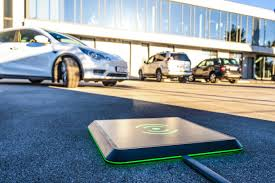In a world where urban landscapes are rapidly evolving, wireless EV charging is poised to be the next big leap in technology. Imagine pulling up to a parking space and having your electric vehicle (EV) charge without plugging in a single cable. This futuristic scenario is becoming a reality with significant advancements in wireless EV charging technology. According to a recent report by Bloomberg Green, the global wireless EV charging market is expected to grow at an annual rate of 45% by 2024. In this article, we’ll explore how wireless EV charging could revolutionize urban mobility in 2024, transforming how we view and utilize electric vehicles in bustling city environments.
Understanding Wireless EV Charging Technology
The Basics of Wireless Charging
Wireless EV charging, often referred to as inductive charging, uses electromagnetic fields to transfer energy between two objects. This technology relies on a charging pad placed on the ground and a receiver on the underside of the vehicle. Here’s how it works:
- Inductive Coupling: The charging pad creates an oscillating magnetic field, inducing an electric current in the receiver coil of the vehicle.
- Efficiency Levels: Recent advancements have pushed the efficiency of wireless charging systems to over 90%, as noted by MIT Technology Review.
- User Experience: Drivers simply park over a charging pad, eliminating the hassle of dealing with cables.
Current Developments and Players
Several companies and car manufacturers are investing heavily in wireless charging technology:
- BMW and Hyundai: Both brands have already tested wireless charging systems with select models.
- WiTricity: A leading name in the field, WiTricity is working with major automakers to integrate this technology seamlessly.
- Tesla: Known for innovation, Tesla is rumored to be exploring wireless charging options, potentially expanding their charging network beyond the Supercharger.
How Wireless EV Charging Benefits Urban Mobility
Reducing Urban Clutter
One of the primary benefits of wireless EV charging is its potential to decongest urban areas:
- Reduced Infrastructure: Without the need for cables and chargers, cities can free up valuable space.
- Cleaner Aesthetics: Charging pads integrated into parking spaces provide a tidier and more visually appealing urban environment.
Enhanced Convenience for EV Owners
Wireless charging stations offer unparalleled convenience, particularly in urban settings:
- Ease of Use: Drivers can charge their vehicles effortlessly, improving the overall EV ownership experience.
- Time-Saving: No more fumbling with cables, making it ideal for busy city dwellers.
Supporting Public Transport Systems
Wireless charging is not limited to personal vehicles. Public buses and taxis could benefit significantly:
- Fleet Integration: Cities like Oslo are already testing wireless charging for public transport, according to Reuters Mobility.
- Operational Efficiency: Buses can charge at stops, reducing downtime and increasing route efficiency.
Practical Guide: Adopting Wireless EV Charging
How to Set Up Wireless Charging at Home
For those interested in home systems, here’s a quick guide:
- Check Compatibility: Ensure your EV is equipped with a wireless charging receiver.
- Select a System: Companies like Plugless and WiTricity offer home systems suitable for various models.
- Professional Installation: Hire a certified technician to install the charging pad and necessary electrical components.
Finding Wireless Charging Stations
As cities expand their infrastructure, finding these stations becomes crucial:
- Mobile Apps: Apps like ChargePoint and PlugShare include wireless charging locations.
- City Initiatives: Some urban areas are launching pilot projects to test and implement public wireless charging stations.
Comparing Costs: Wired vs. Wireless Charging
While wireless charging is convenient, it’s essential to consider the costs:
- Installation: Wireless systems may have higher initial setup costs.
- Efficiency: Although highly efficient, some energy is lost compared to wired charging.
- Long-Term Benefits: The convenience and potential for energy management may offset initial expenses.
Conclusion: The Future of Urban Mobility
As we move towards 2024, wireless EV charging is set to become a cornerstone of urban mobility. By offering a cleaner, more convenient, and efficient way to power electric vehicles, wireless charging addresses many current challenges faced by cities and EV owners alike. This technology not only enhances the user experience but also supports sustainable urban development. As more cities and manufacturers adopt wireless solutions, we can expect to see a significant shift in how electric vehicles are integrated into our daily lives.
Are you ready to embrace the future of transportation? As urban areas continue to expand and evolve, the adoption of wireless EV charging could very well redefine how we think about mobility in the coming years. What are your thoughts on this exciting development? Share your ideas and join the conversation on the future of urban mobility.

